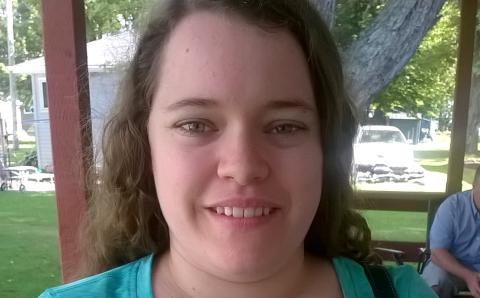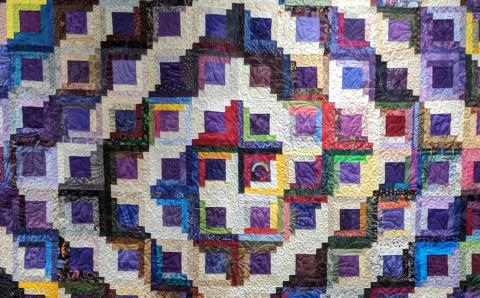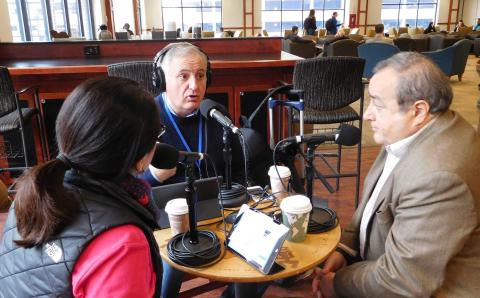When two elephants are fighting, it is the grass that suffers. The government and the LRA, of course, are the two elephants, and the people are the grass. The grass is crying out, “I am innocent! I am innocent!” And we are the voice of this grass.
—Monsignor Matthew Odong, Catholic seminary rector
For 20 years the rebel movement of Joseph Kony’s Lord’s Resistance Army (LRA) held northern Uganda under a reign of terror, abducting boys to be child soldiers and girls to be sexual partners for rebel officers. In a nation that had already suffered from brutal autocracies such as that of Idi Amin, LRA raids on towns and villages—and equally savage responses from the Ugandan army—broke up families, destroyed crops, and killed or maimed anyone who resisted.
A large majority of Ugandans (85 percent, in the 2014 census) are Christian, while 15 percent follow Islam. Tension and competition have existed between religious groups for centuries—not just between Muslims and Christians but between Protestants and Catholics. In the late 1980s, Joseph Kony claimed to be a spiritual leader who would purify the land and unite the people. He and his followers honored both Muslim and Christian holy days each Friday and Sunday. Like an Old Testament prophet, he called for prayer and fasting and strict adherence to the Ten Commandments. Unlike a biblical prophet, he claimed that a host of different spirits spoke to him each day, handing down rules for his followers and directing his military operations against the Ugandan government.
Few took Kony’s religious claims seriously. But as the movement he started became more and more violent, the horrors inflicted by LRA soldiers fell on everyone in the Acholi region. In response to the rebellion, the government forced the entire rural population of nearly two million people to move to overcrowded camps for displaced persons—camps where they could not farm or do other work and where disease was rampant.
Meanwhile, the world outside East Africa paid little attention. Not until 2012, long after the LRA had stopped its raids, did the video “Kony 2012,” with 100 million views, draw the attention of the world to the suffering Ugandans had endured. The video’s depiction of Africans suffering helplessly while they waited for American volunteers and soldiers to rescue them angered Ugandans.
In 2012 and again in 2014, I traveled to Uganda with students from Calvin College to learn about church-assisted development programs in collaboration with staff members of World Renew, a development agency of the Christian Reformed Church, and with Anglican and Catholic leaders whom I had met earlier. We asked our hosts and the people of villages we visited what kinds of development initiatives had strengthened their communities and provided lasting benefit.
Farmers told us remarkable stories of how they had learned to increase yields while protecting the soil and conserving water. Members of village savings and loan associations have been able to open small shops and earn enough to buy school uniforms and supplies for their children. The students gained a deeper understanding of what effective development programs—including World Renew, which works closely with the Church of Uganda (Anglican) in the north and Pentecostal churches in the south—can achieve while addressing persistent challenges of poverty and poor infrastructure.
In northern Uganda, we also heard stories of LRA violence. We talked to men who had been abducted to become child soldiers and then given a choice by their commanders: either beat an innocent person to death or be killed. We heard stories of young girls kidnapped at age 14 and forced to be sex slaves of LRA officers and servants of their older wives.
But we also heard another story—a story hardly known to the outside world even today. It is a story that inspires hope, not horror. It shows what can be accomplished when religious communities come together, overcoming centuries of mistrust, to seek reconciliation and peace. During one of the darkest periods of the conflict, in the late 1990s, leaders of the Protestant, Catholic, and Muslim communities came together to form a new organization, the Acholi Religious Leaders Peace Initiative (ARLPI).
Given Uganda’s religious history, bringing Protestants, Catholics, and Muslims together was a remarkable achievement. After Catholic and Protestant missionaries came to the region in the mid-19th century, each group accused the other of kidnapping pupils from mission schools to inflate the numbers of converts. Islam was present in Uganda long before the arrival of Christian missionaries, but even today Christians and Muslims view each other with mistrust and suspicion. Yet the leaders of the three communities had the courage to come together, knowing that they could accomplish far more together than they could alone.
The coalition set to work along three parallel tracks. First, it sought to offer help and comfort to those who were suffering the effects of the civil war, from LRA violence or from equally destructive government campaigns. Second, it brought the conflict to the attention of religious communities, governments, and nongovernmental organizations outside Uganda. Third—and most risky—ARLPI set out to bring the two sides together to resolve the conflict.
One of the most powerful channels for communicating with the outside world was devised not by religious leaders or politicians, but by village children. Outside the larger towns, LRA raids were a constant danger, and children were far more likely to be abducted than adults. So the children put blankets under their arms and began walking every evening to the larger towns, five or 10 miles away. They would sleep in bus parks or church compounds for the night and set out early to report for morning assembly at their village schools. At first the residents of the towns were wary: Were these LRA child soldiers in disguise? But religious leaders welcomed them. Pastors and priests and imams would greet the children arriving from their villages, provide water and food, and join them to sleep outside. Peace initiative leaders sent reports and pictures to colleagues abroad, and some international media picked up the story.
In the early 2000s, the Ugandan government claimed that its military victory over the LRA movement was almost complete, but travel was too risky for foreign journalists to see the situation for themselves. Images of churchyards and bus stations filled with children seeking safety by becoming “night commuters” showed that the suffering continued.
Meanwhile, leaders of the peace initiative continued to offer other forms of assistance: helping to reunite families of abductees who had escaped, trying to locate abducted children, and caring for those whose homes and crops had been destroyed. They pressed on too in their efforts to bring the two sides together—the most difficult and dangerous part of their work.
Government officials agreed to meet with the religious leaders of the peace initiative, but they insisted that negotiation was useless. Only military force, they said, could end the rebellion. Moreover, the government suspected ARLPI leaders of being secret sympathizers with the rebels simply because they shared their Acholi ethnic identity.
Meeting with the LRA was far more difficult. Time and again ARLPI representatives were taken blindfolded to remote camps, uncertain whether they would return alive. LRA commanders suspected the pastors and priests of being government informants. Kony refused to attend the meetings, fearing betrayal, and it was never clear whether the representatives he sent had the authority to make agreements.
And yet the talks continued. Ceasefires were announced―and then promptly broken. Plans for an LRA withdrawal were discussed but not implemented. At last both sides agreed to formal negotiations to be held in Juba, in the region (now nation) of South Sudan. Between 2004 and 2006, a plan for LRA withdrawal was drafted. These talks were convened by the Sudanese government and facilitated by the Catholic lay community of Sant’Egidio. At that point, ARLPI, having prepared the way, stepped into the background.
Beginning in 2006, men and women who had been abducted to LRA camps were released, and the LRA withdrew from Uganda. Travel in the region once again became possible. Residents of the government camps for internal refugees returned to their farms and villages and their former lives as farmers and traders, even though many homes and shops had been destroyed and many farms taken over by squatters. A small band of Kony’s followers remains with him to this day—perhaps 100 in all, staging occasional raids for food and supplies and then retreating into hiding in remote regions of neighboring countries.
The work of the peace initiative was far from finished, however. One of the founders of the group told me: “It will take 50 years to rebuild. The guns are silent, yes. But think of what the guns have done to the people.”
After the LRA withdrew, the leaders of the peace initiative changed their focus. New priorities included rehabilitation of returning abductees, resolution of land disputes, empowerment of women, and promotion of sustainable agriculture.
A top priority today, staff members told me, is creating interfaith peace committees in every district and every village. Too often, they said, ARLPI initiatives have been planned and begun from the top. But lasting change happens only when local communities assess their own needs and take action.
The story of ARLPI and its faithful witness to peace and reconciliation, beginning in the midst of one of the world’s most savage civil wars, shows how powerful the witness of religious communities can be when they join forces in pursuit of peace. Where conflict between Christian and Muslim communities flares into violence in many regions of the world, the example of northern Uganda shows how much can be accomplished when they come together, respecting each other’s deep differences but seeking ways of following God’s will together. And contrary to the impression given by Western media reports and videos such as “Kony 2012,” the success of the peace initiative shows that African communities can resolve seemingly impossible problems when they use their own resources and put their own vision of a better future into practice.
The most urgent crisis facing Uganda and its neighbors today is the massive exodus from war-torn neighbors such as the Democratic Republic of Congo and South Sudan. Fleeing civil war and political repression or simply escaping from dire poverty and crop failure, 1.4 million refugees are seeking a new start in Uganda, according to United Nations figures. But even as the number of global refugees swells, American doors are being slammed: In the fiscal year that ended in September 2018, only 22,491 refugees were admitted, the lowest number in more than two decades.
During our stay, my students and I received permission to visit a camp for refugees from civil war in the Democratic Republic of the Congo. In Uganda, local and national governments work together, with assistance from international agencies, to provide temporary food and shelter to everyone who seeks refuge from violence at home. Within a few months each family is provided a plot of land and materials with which to build a home. Pastors from nearby villages come to the camps to lead singing and prayer and to invite the residents to their churches.
When we expressed our amazement at the openness of Ugandans to these newcomers, local government officials responded, “This is our obligation under the Charter of the United Nations, which Uganda has ratified. So we cannot turn them away.”
The East African region is under enormous strain as the flow of refugees from countries wracked by conflict grows larger and larger. But the same spirit of cooperation and compassion so evident in the work of the peace initiative and at all of the villages we visited were present in the refugee camp. When people are suffering, why should it matter whether they are Protestant or Catholic or Muslim, whether they are Congolese or Somalian or Sudanese? They are our brothers and sisters, so we must help them.
In providing relief from LRA violence, in working courageously for peace, in helping rural residents provide for themselves, in assisting those fleeing for their lives—in all these contexts the religious communities of Uganda, and many local authorities as well, showed by their actions what it means to love our neighbors. Their grassroots example—grass that was trampled but sprang up again—inspires our own call to seek peace.
About the Author
Since retiring as administrator and professor at Calvin University, David resides in Michigan and Arizona. He is a member of Second Christian Reformed Church in Grand Haven, Mich., and an affiliate at Southside Presbyterian Church in Tucson, Ariz. His most recent book is, We Are the Voice of the Grass: Interfaith Peace Activism in Northern Uganda (Oxford University Press).








